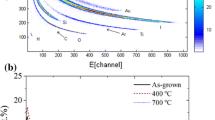Abstract.
Nanocomposite thin films formed by Cu nanocrystals (NCs) embedded in an amorphous aluminium oxide (Al2O3) host have been prepared by alternate pulsed laser deposition. Spectroscopic ellipsometry is used to determine the effective refractive index (n=n+ik). The extinction coefficient is non-negligible and shows a broad absorption band related to the surface plasmon resonance. In the neighbourhood of this wavelength, the real part of the refractive index undergoes an anomalous dispersion, leading to a significant increase of the n value of the composite compared to that of the host. When the Cu content is low enough, about 2 at. %, the use of an effective medium approach combined with a regression method allows us to determine the metal content and film thickness from the ellipsometric measurements. For larger concentrations this approach is no longer valid.
Similar content being viewed by others
Author information
Authors and Affiliations
Additional information
Received: 31 July 2001 / Revised version: 21 September 2001 / Published online: 15 October 2001
Rights and permissions
About this article
Cite this article
Serna, R., Gonzalo, J., Afonso, C. et al. Anomalous dispersion in nanocomposite films at the surface plasmon resonance. Appl Phys B 73, 339–343 (2001). https://doi.org/10.1007/s003400100718
Issue Date:
DOI: https://doi.org/10.1007/s003400100718




